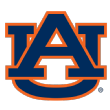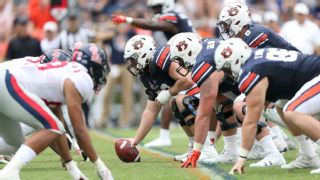|
The last time Lamar Jackson played Syracuse, he was mostly a local curiosity, an athletic sophomore making his second start of the season, coming off a rather ridiculous eight-TD performance against an overmatched opening week opponent. Then he posted 610 yards of offense, scored five times and leapt over a defender against the Orange, and suddenly, Jackson was the next big thing, a true Heisman contender. Jackson's Cardinals are set to play Syracuse again this week, and while the QB's game has only improved since his 2016 Heisman moment, that buzz has all but disappeared. The oddsmakers have Jackson's Heisman hopes at 40-to-1, seventh-best at the moment, behind less productive quarterbacks.  ESPN's Heisman Watch has him fourth, but with just one top-two vote, and well behind Arizona's Khalil Tate, who despite sitting the bench the first month of the season has become this year's version of 2016 Jackson. And while an informal survey of two dozen Heisman voters we conducted for this story showed that the majority considered Jackson worthy of a top-five spot on their ballot, few viewed him as a serious candidate. So why is there so little enthusiasm surrounding a defending Heisman winner having a better overall year? "While not based strictly on team performance, he hasn't had the chance to have a big moment in a big game, because [Louisville] no longer has big games," one Heisman voter said. "Whereas Baker Mayfield is playing in them every week." Here lies the problem for Jackson. His Louisville team is 6-4 on the season, dominated by Clemson, beaten by NC State, Boston College and Wake Forest, losers of seven of its past 11 games vs. Power 5 competition dating back to last year. It's hard to fault Jackson for that, but it's a reality that overshadows most everything else. Of the 81 previous Heisman recipients, only one played on a losing team. Just two others played on teams with four losses or more. So is that's what's holding Jackson back? "I can't speak for people," Jackson said. "I go by how I play and how my team performs." Jackson's numbers certainly suggest he belongs in the conversation. While his team has struggled, he's flourished, even in comparison to last year's Heisman season. Through 10 games, he has more total yards, more passing yards, a higher completion percentage and just 32 fewer rush yards when accounting for garbage time (i.e. the score is within three touchdowns). He's also clearly progressed as a player overall, working more from the pocket and showcasing his skills as a passer and not just an athlete. "I stay in the pocket more. When I throw the ball, I'm on target, and if my first target isn't there, I go to the next one. I've done that a lot this year," Jackson said. "I know I've shown a lot that I can throw the ball, I can hit any area on the field. I do it all day in practice and in games, I try to do the same thing." Perhaps the best case for Jackson, however, is that he has simply been the only real weapon for the Cardinals. He has accounted for 77 percent of the Cardinals' total yards this year -- a full 6 percentage points more than any other Power 5 player, and well ahead of Oklahoma's Baker Mayfield (63 percent), the current Heisman favorite. In the past decade, only four other Power 5 players have accounted for a higher percentage of his team's yardage through 10 games, and only one -- Texas Tech's Patrick Mahomes last year -- had more total yards than Jackson does now. Louisville has been a mediocre team, yes, but it might be downright horrible without him. "I thought he was being hamstrung by the attempt to make him more of a pocket passer in more of an Air Raid style of football," said Larry Williams, a Heisman voter who said he has closely watched about half of Jackson's games this year. "I do think it's more than fair to say he had more help last year at the other skill positions, not to mention a defense that was far better last year. So in that respect, if he's putting up similar numbers with not nearly as much help there's a legitimate case to be made that he deserves the vote this year even more than last year." So should Jackson's performance be negated because his team has struggled or appreciated because he's doing more with less? In our poll of Heisman voters, all but one said a team's record has some impact on how they view a player's performance. About 20 percent of voters said they wouldn't consider a player whose team had lost at least four games (as Louisville has). And while about two-thirds said they did still think of Jackson as a top-five candidate for the award, most suggested his lack of opportunities to play in big games -- and his mediocre numbers when he has played in them -- impacted their perception of his season. Jackson posted solid enough numbers against Clemson, but just 159 of his 381 yards came when the game was still reasonably close. Nearly 40 percent of his yards against NC State came in the final quarter as Louisville desperately tried to erase a deficit. Were those struggles a product of a less-audacious Jackson or of a team that simply didn't offer him much help? Odds are most voters won't dig into the nuance when there are credible alternatives in Mayfield and Stanford's Bryce Love. Players who lift a team from good to great are lauded. Players who drag their team from bad to mediocre are easily forgotten. For his part, Jackson said he truly isn't concerned. He has the hardware already, and while winning it twice would certainly put him in elite company -- just one player, Ohio State's Archie Griffin, has done it -- there's little sense in campaigning for a trophy when there's still work to be done on the field. "It's an honor and a blessing, and a lot of people are never in the race," Jackson said of the Heisman. "It's a blessing for me to be in it, and I'm thankful for that." So does he believe he's the best player in the country? Jackson has learned enough from the spotlight since his last time accepting the trophy to offer a perfectly political reply. "I just give it my all," he said. Four downsThe only FBS player to rush for at least 70 yards in every game this season is Wisconsin's Jonathan Taylor. That also puts Taylor in some impressive company historically. In the past decade, only five other Big Ten runners have hit 70 yards in each of their team's first 10 games: Ezekiel Elliott, Tevin Coleman, Ameer Abdullah, Venric Mark and Shonn Greene. Four went on to play in the NFL. None were freshmen, as Taylor is this year. Is all hope lost for Georgia and Notre Dame after they fell last week in convincing fashion? In the playoff era, 11 other teams have been ranked in the committee's top four and lost in the regular season. Of that group, two still went on to make the playoff: Clemson and Washington, both last season. Since taking over the starting job for an injured Mark Walton five weeks ago, Miami tailback Travis Homer has rushed for 4.75 yards per carry or more four times -- all vs. Power 5 opponents. In 22 career games vs. Power 5 teams, Walton hit that mark just four times total. Tennessee will play its first game after Butch Jones was fired when it hosts No. 20 LSU on Saturday. A midseason coaching change might've looked like a nice way to jolt some energy into a team the past few years. In 2015, there were seven midseason changes, and those teams went 4-3 the week after their coaches were fired. In 2016, there were five changes, and those teams were 3-2 the week after. This year though? Not so good. There have been four changes prior to Jones' dismissal this year, and those teams were not only 0-4 in the immediate aftermath but the group -- Florida, UTEP, Georgia Southern and Oregon State -- are a combined 0-12 under their interim coaches.
Coach speak It's amazing that the same Auburn offense that delivered a balanced, dominating performance last week against Georgia is the same group that caved for 11 sacks and averaged less than a yard per rush in a Week 2 loss at Clemson. "We're light years ahead right now," Tigers coach Gus Malzahn told ESPN.com. Malzahn never lost confidence in his scheme, and neither did his players, especially an offensive line that overcame injuries, lineup shuffling and an evolving identity under new coordinator Chip Lindsey, who was brought in to instill more pass-run equilibrium. Although running back Kerryon Johnson and quarterback Jarrett Stidham are the frontmen for Auburn's surge, Malzahn singled out lineman Austin Golson, who is the first Tiger since at least 1986 to start at four different line positions (left tackle, left guard, center and right tackle). "I've never had a player that started at two different positions, much less four," Malzahn said. "And it hasn't been a drop-off. He's a very intelligent player. He understands the game. He's like a coach on the field. He has experience. A lot of offensive linemen would be very uncomfortable doing that." It's amazing that the same Auburn offense that delivered a balanced, dominating performance last week against Georgia is the same group that caved for 11 sacks and averaged less than a yard per rush in a Week 2 loss at Clemson. "We're light years ahead right now," Tigers coach Gus Malzahn told ESPN.com. Malzahn never lost confidence in his scheme, and neither did his players, especially an offensive line that overcame injuries, lineup shuffling and an evolving identity under new coordinator Chip Lindsey, who was brought in to instill more pass-run equilibrium. Although running back Kerryon Johnson and quarterback Jarrett Stidham are the frontmen for Auburn's surge, Malzahn singled out lineman Austin Golson, who is the first Tiger since at least 1986 to start at four different line positions (left tackle, left guard, center and right tackle). "I've never had a player that started at two different positions, much less four," Malzahn said. "And it hasn't been a drop-off. He's a very intelligent player. He understands the game. He's like a coach on the field. He has experience. A lot of offensive linemen would be very uncomfortable doing that."
  You've probably noticed all the different Miami defenders wearing the world famous Turnover Chain this season? It's by design. "We call ourselves an equal opportunity, playmaking defense," Hurricanes defensive coordinator Manny Diaz said. "The style of defense we play, it's not set up for this guy to make all the tackles or the plays." Diaz actually had an easier time emphasizing the philosophy last season, when the defense was younger and less decorated. The unit struggled to begin this year as certain players "trying to justify the hype" went beyond their assignments, leading to problems. But after several close wins in October, Diaz saw the players commit to trusting their teammates and their assignments. Safety Jaquan Johnson has emerged as a star, earning national defensive player of the week honors for his performance against Notre Dame (eight tackles, one tackle for loss, interception, pass deflection). As the boundary safety, Johnson is key to limiting big plays. "We haven't given up long touchdowns since the Toledo game, which means your secondary's tackling," Diaz said. "Jaquan is usually the first responder. He's the guy closest to the ball, so he's going to be the first guy asked a question if something bad happens." You've probably noticed all the different Miami defenders wearing the world famous Turnover Chain this season? It's by design. "We call ourselves an equal opportunity, playmaking defense," Hurricanes defensive coordinator Manny Diaz said. "The style of defense we play, it's not set up for this guy to make all the tackles or the plays." Diaz actually had an easier time emphasizing the philosophy last season, when the defense was younger and less decorated. The unit struggled to begin this year as certain players "trying to justify the hype" went beyond their assignments, leading to problems. But after several close wins in October, Diaz saw the players commit to trusting their teammates and their assignments. Safety Jaquan Johnson has emerged as a star, earning national defensive player of the week honors for his performance against Notre Dame (eight tackles, one tackle for loss, interception, pass deflection). As the boundary safety, Johnson is key to limiting big plays. "We haven't given up long touchdowns since the Toledo game, which means your secondary's tackling," Diaz said. "Jaquan is usually the first responder. He's the guy closest to the ball, so he's going to be the first guy asked a question if something bad happens."
 Quarterback Khalil Tate undoubtedly has transformed Arizona's offense, which has scored 35 points or more in each of the past six games with him at the helm. But there's more to it than Tate. The Wildcats have a nice mix of running backs with redshirt freshman speedster J.J. Taylor, veteran Nick Wilson and 229-pound tractor Zach Green. "You're putting more options on the table that are playing much more efficient than in the beginning of the year," Arizona co-offensive coordinator Rod Smith said. "Khalil is demanding a lot of attention, obviously, so he's generating seven-, eight-, nine-man boxes, depending on what formation we're in. That's all fine and dandy if you keep anything in front of you but if something creases, there's not much behind it." Smith added that the offensive line has improved with experience. Arizona starts four seniors up front and boasts 140 career starts and 177 career appearances among its top six linemen. "They've seen every look we're going to face," Smith said. "We've seen it, done it and been able to adjust to it, even if it's something we haven't prepared for. That's a luxury to have." Quarterback Khalil Tate undoubtedly has transformed Arizona's offense, which has scored 35 points or more in each of the past six games with him at the helm. But there's more to it than Tate. The Wildcats have a nice mix of running backs with redshirt freshman speedster J.J. Taylor, veteran Nick Wilson and 229-pound tractor Zach Green. "You're putting more options on the table that are playing much more efficient than in the beginning of the year," Arizona co-offensive coordinator Rod Smith said. "Khalil is demanding a lot of attention, obviously, so he's generating seven-, eight-, nine-man boxes, depending on what formation we're in. That's all fine and dandy if you keep anything in front of you but if something creases, there's not much behind it." Smith added that the offensive line has improved with experience. Arizona starts four seniors up front and boasts 140 career starts and 177 career appearances among its top six linemen. "They've seen every look we're going to face," Smith said. "We've seen it, done it and been able to adjust to it, even if it's something we haven't prepared for. That's a luxury to have."
 Wisconsin is a breeding ground for physical running backs, and freshman Jonathan Taylor is the latest Badgers bruiser. But there's something different about Taylor, who leads the nation in rush yards after contact (1,353). "I was talking with [running backs coach John Settle] the other day," offensive coordinator Joe Rudolph said, "and it's funny because, at times, he plays so physical and I don't even think he knows when he's doing it. He's just playing. That's different for a guy who's as explosive as he is." Taylor isn't a plodder. He's tied for the national lead in rushes of 10 yards or more with 49, and could join Melvin Gordon as the only Wisconsin back to average seven yards or better in a season (he currently averages 6.96 yards per rush). Although Taylor has contributed in every game -- five performances of more than 150 rush yards -- he has dealt with some minor injuries and four lost fumbles. "It hasn't all been perfect," Rudolph said. "He's had to fight through adversity at times, and he has. He's responded. And I'm proud of him for those things." Wisconsin is a breeding ground for physical running backs, and freshman Jonathan Taylor is the latest Badgers bruiser. But there's something different about Taylor, who leads the nation in rush yards after contact (1,353). "I was talking with [running backs coach John Settle] the other day," offensive coordinator Joe Rudolph said, "and it's funny because, at times, he plays so physical and I don't even think he knows when he's doing it. He's just playing. That's different for a guy who's as explosive as he is." Taylor isn't a plodder. He's tied for the national lead in rushes of 10 yards or more with 49, and could join Melvin Gordon as the only Wisconsin back to average seven yards or better in a season (he currently averages 6.96 yards per rush). Although Taylor has contributed in every game -- five performances of more than 150 rush yards -- he has dealt with some minor injuries and four lost fumbles. "It hasn't all been perfect," Rudolph said. "He's had to fight through adversity at times, and he has. He's responded. And I'm proud of him for those things."
 The prospect of not scoring in the second half of a Big 12 game signals certain defeat. But West Virginia not only won one league contest despite going scoreless after halftime, it claimed consecutive games against Iowa State and Kansas State. The reason is a defense that overcame early season injuries to receive contributions from both veterans and younger players. Coordinator Tony Gibson can't overstate the significance of David Long's return after the linebacker missed the first month with a knee injury. Long has 52 tackles, including 11 tackles for loss, and six pass breakups and a forced fumble despite playing in only six games. "That kid's as good as any defensive player in the country," Gibson said. "I don't know one defense he couldn't play on." WVU also has received a lift from true freshman Kenny Robinson, who made the game-winning stop against Iowa State and had a red zone interception at Kansas State. "We had so many new guys coming in and we've had six or seven different starting lineups on defense due to injury and trying to get guys in the right spots," Gibson said. "The last two weeks, we've had the same lineup and the kids are really confident." The prospect of not scoring in the second half of a Big 12 game signals certain defeat. But West Virginia not only won one league contest despite going scoreless after halftime, it claimed consecutive games against Iowa State and Kansas State. The reason is a defense that overcame early season injuries to receive contributions from both veterans and younger players. Coordinator Tony Gibson can't overstate the significance of David Long's return after the linebacker missed the first month with a knee injury. Long has 52 tackles, including 11 tackles for loss, and six pass breakups and a forced fumble despite playing in only six games. "That kid's as good as any defensive player in the country," Gibson said. "I don't know one defense he couldn't play on." WVU also has received a lift from true freshman Kenny Robinson, who made the game-winning stop against Iowa State and had a red zone interception at Kansas State. "We had so many new guys coming in and we've had six or seven different starting lineups on defense due to injury and trying to get guys in the right spots," Gibson said. "The last two weeks, we've had the same lineup and the kids are really confident."
|

